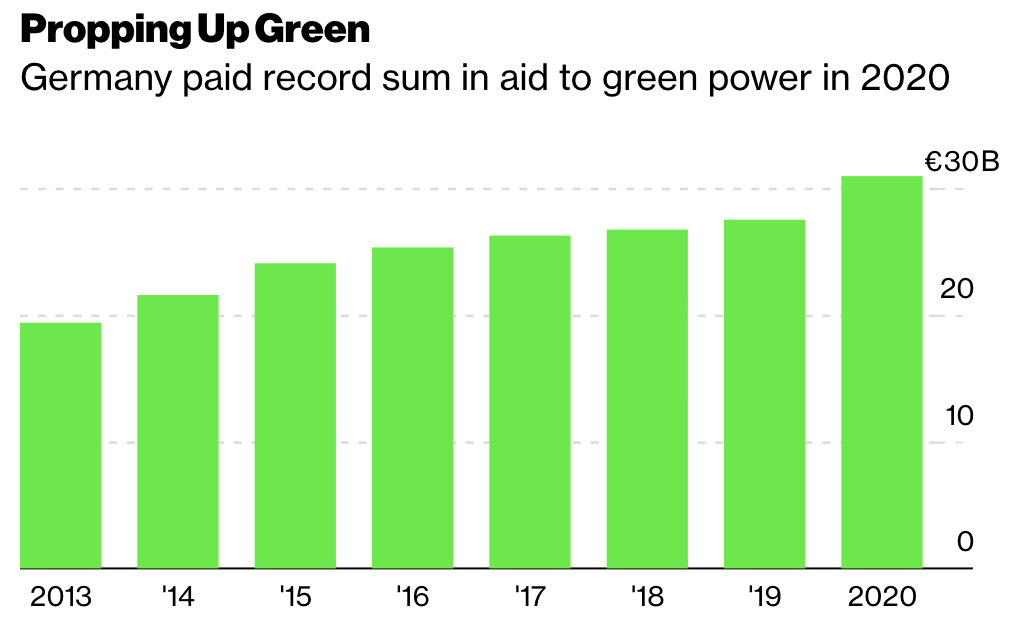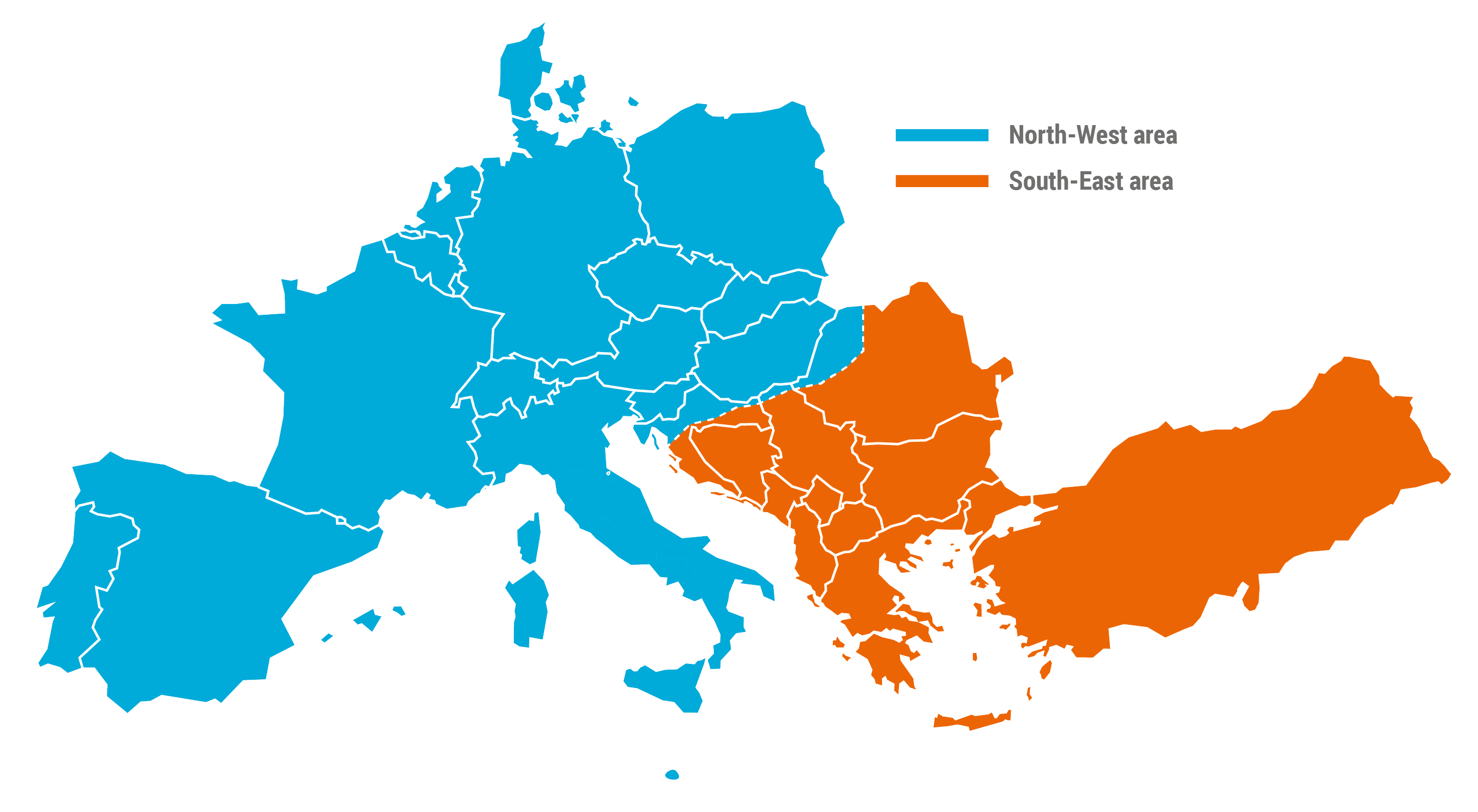Germany’s millions of solar panels are blanketed in snow and ice and its 30,000 wind turbines are doing nothing as the freezing weather has no wind resource to keep the turbines operating. Instead, the solar and wind units are drawing power from the grid powered mainly by coal to keep their internal workings from freezing up. Despite Germany being the poster child of Europe’s renewable future, the country’s Energiewende—transition to wind and solar power—is not working. The Germans have found that dependable, dispatchable coal can work in any weather and is the savior during these cold months. The plan is that Germany will have to rely more on natural gas from Russia, coal power from Poland and nuclear power from France, importing power along huge cables, instead of building a huge fleet of batteries to back up its intermittent renewable power.
However, for this unreliability of wind and solar power during this year’s snowy and icy winter, German consumers paid $38 billion ($30.9 billion euros) in subsidies for its renewable energy growth in 2020, despite the financial needs of other sectors of its economy afflicted by the coronavirus pandemic. The renewable energy subsidy is paid directly by consumers in their electricity bills, helping make German residential retail power costs the highest across the European continent and 3 times higher than those of the United States. Americans need only triple their utility bills to get a sense of the burden Germany’s system places on its citizens. The U.S. economy is about 5 times the size of Germany’s, to compare relative expenditures for similar practices. The subsidy only raised renewable energy’s share of Germany’s electricity mix by 3 percentage points—from 43 percent in 2019 to 46 percent last year.

Over the next two years, the German government plans to take a third off the costs that consumers pay by using some of the nation’s budget to share the burden. The costs of the subsidy, known as Renewable Energy Law aid, are expected to peak in 2022-2023 before stabilizing. Germany switched to auctions to expand wind and solar capacity in 2017, abandoning the system of guaranteed feed-in tariffs for all new renewable projects to reduce the increasing expense burden.
Joe Biden needs to use caution on his plans for a 100 percent carbon free electricity sector by 2035 and his carbon free U.S. energy sector by 2050 as Germany—the first country to take on the 100 percent carbon free electricity future in Europe—is failing in its ability to keep the lights on using solely carbon free power. Solar and wind power achieve less than half of the energy carbon sources achieve, despite massive subsidies.
Europe’s Power Grid Avoids Blackout
Extremely cold weather caused power demand to surge across Western Europe on January 8 and the continent’s electricity network came close to a massive blackout. Europe’s grid, which is usually connected from Lisbon to Istanbul, split into two as the northwest and southeast regions struggled to keep the same frequency. The problem originated in Croatia due to a fault at a substation that caused overloading on other parts of Croatia’s grid. It led to the equivalent of 200,000 households losing power across Europe. Supply to industrial sites was cut in France and Italy.

As Europe replaces large coal and nuclear stations with thousands of smaller wind and solar units and as sectors electrify via intermittent sources due to policy edicts to reduce carbon dioxide emissions, the possibility of blackouts is likely to become more frequent.
Large amounts of intermittent electricity create huge swings in supply, which the grid has to be able to handle. European transmission grids need to stay at a frequency of 50 hertz to operate smoothly and any deviations can damage equipment that is connected. The frequency swings on January 8 were reduced within minutes, avoiding damage across the entire European high voltage network, which potentially could have caused blackouts for millions.
Europe has not had a major blackout since 2006 when over 15 million households were out of power for hours. In 2019, there was another narrow escape when the frequency dropped dangerously low. Europe’s grid operators have put in automatic responses like splitting the network and triggering standby generation or demand reduction. Spinning turbines of thermal plants connected to the grid create kinetic energy called inertia which helps keep the network at the right frequency. The spinning cannot be created by wind turbines or solar panels.
The European near-blackout shows that problems in one nation can rapidly cascade as states become more reliant on their neighbors for power. Continental Europe was separated into two areas due to outages of several transmission network elements in a very short time. Longer, harder to fix disturbances that rip across countries are a real threat.
Europe is Not Alone
In Australia, wind power was blamed for a blackout in 2016 that cut supply to 850,000 homes. Australia was the first country to install a 100-megawatt mega battery in 2017, hoping that high-cost battery storage could be the solution.
In California, where about a third of its generation is from renewables, record-breaking temperatures caused rolling blackouts as the state’s electricity supplies could not keep up with demand, particularly when solar plants stopped generating for the day and were 33-percent less effective due to the smoke from the state’s wildfires. Like Australia, California utilities are looking to large batteries to help solve the problem of intermittent electricity from wind and solar power, though the state also imports a large amount of power from neighboring states that were also having record-breaking temperatures this past summer and thus, not able to help with California’s energy demand
Conclusion
Countries and states with a great deal of intermittent electricity from wind and solar power are having problems keeping the lights on when the weather does not cooperate. Germany had to turn to coal this past winter when freezing temperatures made its solar and wind units inoperable and it plans to import from neighboring countries to back-up its renewable electricity in the future, as its continues to retire its coal plants. Australia’s answer to its 2016 blackout caused by lack of wind power is to obtain high-cost batteries to store excess energy when the wind does not blow. California, which already imports electricity from neighboring states, got hit by record breaking temperatures and had to use rolling blackouts when the country’s solar and wind units could not meet demand. The state is also planning on using high-cost batteries to store its excess power for later use.
Joe Biden’s plans are to put the United States into the same situation as Germany, Australia, and California by his campaign promises to make the U.S. electricity sector carbon free by 2035—10 years earlier than even California has planned—and the U.S. energy sector carbon free by 2050. Americans need to be aware of the situation that other countries are facing when they turn to intermittent renewables. The record so far is not good.



